Asymmetric Information Economics
from Stigliz New Economics
Category: ECO
Published: 2002
#1419b
Shiro Yabushita (藪下史郎)
up 14830
Title
Asymmetric Information Economics
非対称情報の経済学
Index
Tag
Premises of perfect competitive market; Joseph E. Stigliz; Causes of asymmetric information; Adverse selection; Moral hazarad; Japanese labor practices; Institutionalism vs. Neoclassical economics; Stability vs. Efficiency Trade-off; Nash Equilibrium; Bent Demand Curve; Liquidity Trap; Money Supply;
Summary
要約
>Top 0. Preface:
- Market economics under asymmetric information has emerging since last three decades, and has established a knew genre of modern economics.
- What is an asymmetric information, and which affects what kind of impacts on our economic activities.
0. 序文:
- 非対称情報下での市場経済論の登場
(30年以前より)
- 非対称情報とは何か
>Top 1. Limit of Traditional Economics:
- Adam Smith:
- All mighty 'invisible hand' in the market mechanism.
- There should be neither unsold dead stock nor unemployment.
- Unemployed workers are only waiting for better jobs.
- Neoclassic economics has inherited these principles in latter 20C.
- Supply and Demand chart attaining Equilibrium was a typical explanation of this theory; automatically adjusted by God's invisible hand.
- Marginal cost and marginal profit:
- Premises of perfect competitive market:
- Uniformity of goods:
- Completeness of information:
- Property of goods:
- Problems: stealing, environmental issues
- Function of the state: mechanism to compliment incompleteness of market mechanism: Cf. Night watch state
- Function of currency: financial institutions
- Bad (non-performing) loan
- Transaction cost
- Safety net:
- Labor conditions: education
- Social disparity:
- Unemployment rate
- Social insurance
1. 伝統的経済学の限界:
- アダムスミスの見えざる手の限界:
- 完全競争市場の前提条件
- 商品の同質性
- 情報の完全性
- 所有権の確立・保護
- 完全競争市場を補完する国家の機能
- 独占市場:
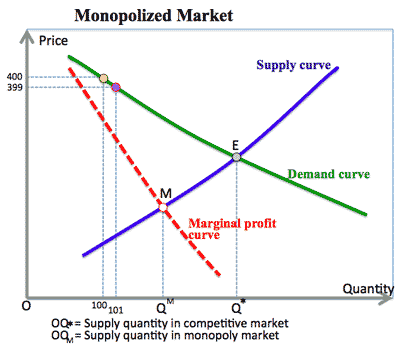
>Top 2. Birth of New Economics:
- Birth of New Economics:
- 2001 Nobel Prize of Economics: "Market under asymmetric information"
- George Acarov; Michael Spense; Joseph Stiglitz
- Unified analysis of Micro & Macro economics under incomplete information
- Joseph Eugene Stigliz (1943- ): born in Gary, Indiana, an industrial city of US Steel
- graduated Amherst University in MA; Liberal Art
- at MIT: studied problems of competition equilibrium
- doctorate at Cambridge University
- became professor of Yale in 1967 at 27.
- specialized in economic growth, technology development, income distribution, finance, global economy
- "The Economics of the Public Sector"; asymmetric information and incentive policies.
- 1969-70: Nairobi University in Kenya.
- Insurance market, Labor market, and Financial market under incomplete information
- CEA (Council of Economic Advisers) of Clinton Administration, then World Bank chief economist, and criticized IFM policy on 1997 Asian financial crisis
- Conventional economics (including Paul Samuelson)
- Micro economics under complete market mechanism
- Macro economics; incomplete employment of Keynesian economics
- Acalov: "Lemon market"
- rejected by "American Economic Review" and UK "Review of Economic Study", and "Journal of Political Economy" of Chicago University
2. 新しい経済学の誕生:
- スティグリッツの経済理論
- "公共経済学"
- 経歴
- Liberal Arts重視の大学教育
>Top 3. Market under Asymmetric Information:
- Causes of asymmetric information:
- Disparity of information between seller and buyer:
-
Seller has more information about goods during production process.
- Asymmetric information increases due to economic development
- Division of labor
- IT technology; e-Commerce
- Case-1: Used car market:
- Asymmetric information in used-car market:
- Buyer has no information about a particular car.
- 'Lemon' used-cars may be included
- Lemon used cars increase according to sales price decreases.
- Demand curve will not show down trend.
- There are two equilibrium points in the chart (1)
- The chart (2) indicates there is no equilibrium point.
- >Top Case-2: Insurance Market:
- Uncertainty and risk
- Lottery buyers don't buy their dreams, but risks. Dreams are not real, which are essentially uncertain.
- Risk challengers and Risk evaders
- Entity who has no essential information:
-
In used-car market: Buyer
- In insurance market: Insurance company
- 'Adverse selection' (or cacogenics)
- Quality of information
-
It costs to maintain credibility of information
- Declare of origin of production
- Brand image
3. 非対称情報下の市場:
- 非対称情報とその原因
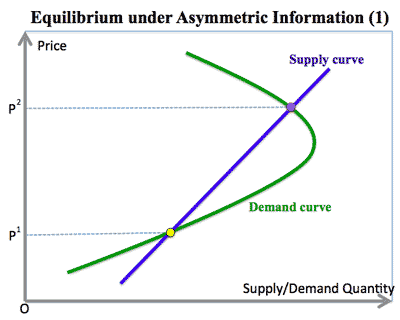
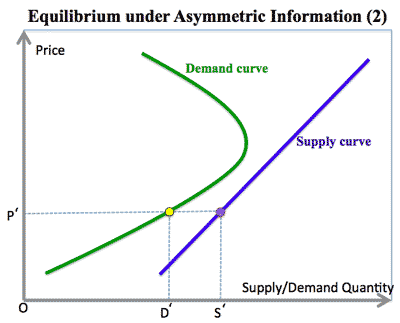
- 逆選択 (逆淘汰)
>Top 4. Moral Hazard and Economic Activities:
- What is 'moral hazard'?
- Lack of incentive to guard against risk where one is protected from its consequences, e.g. by insurance (by Oxford Dictionary)
- Or it even means that insurance policyholder intentionally make or neglect to avoid accident to get the insured amount.
- Insurance company needs to consider risks of adverse selection and moral hazard.
- Expected Profit and Safety Rate (q):
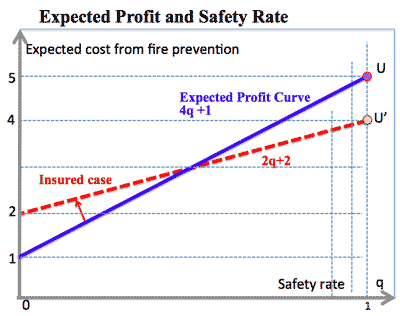
- Blue line: No insured case; q=0 no fire, q=1 fire surely occurs.
- c = h(q) is the cost spent for fire prevention when safety rate is q (0≦q≦1)
- Effort for Fire Prevention (Fig. Right below):
- The marginal cost curve crosses at q*, where the maximus expected profit will be (4q* +1) -h(q*).
- Safety rate is determined endogenously by the policyholder; depending on insurance premium and insured amount.
- Social Security issues:
- Medical and welfare costs are getting serious in recent years.
- Medical services are mostly operated by non-profit basis.
- Medical consultation, examination, operation fee, and medicine fee are covered substantial by medical insurance.
- Moral hazard in medical services:
- Excess examination, excess medicine
- Generally, stability (or fairness) and efficiency have trade-off relationship.
4. モラルハザードと経済活動:
- モラルハザードとは:
- 安全確立と火災防止費用:
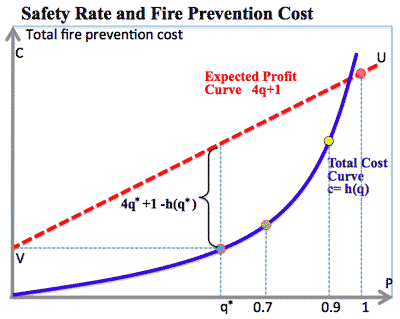
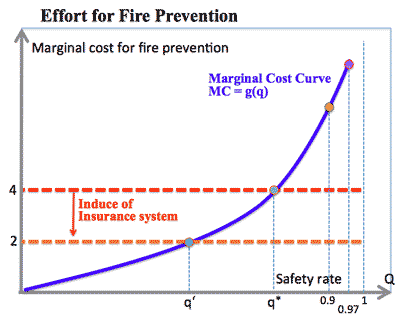
>Top 5. Organization and Systems
- Japanese labor practices: Most of Japanese companies adopted (or at least until 1990) following labor practices:
- Permanent employment
- Less labor mobility
- Seniority payment system
- In-house HRD or OJT
- Enterprise union
- Long-term business transaction
- Stable shareholders
- Employee-centric management
- Indirect finance; Main banking system
- Institutionalism vs. Neoclassical economics:
- New system economics takes a serious view on asymmetric information and various transactions costs, including globalization in economies.
- Corporate governance
- Separation of ownership and management; Principal-agent relationship
- Active shareholders; banks, labors, trade partners
- Incentive mechanism in labors
- Function of NPO's
- Formal rules and informal rules
- Fixed and incentive in pay system
- Centralized or decentralized corporate organization
- Stability vs. Efficiency Trade-off:
- Stable pay may cause moral hazard
- Efficient pay based on achievement may cause instability in pay
- this relationship is applicable to Agricultural tenant-farming system.
- Nash Equilibrium:
- a stable state of a system involving the interaction of different participants , in which no participant can gain by a unilateral change of strategy if the strategies of the others remain unchanged .
- Any one partner select the present situation because of too much changing cost.
5. 組織と制度:
- 日本の労働慣行:
- 制度学派経済学 (W.C.Michell)
- 新古典派経済学
- 賃金の安定性と生産性のトレードオフ
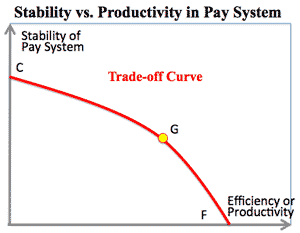
- ナッシュ均衡
>Top 6. Macro Economics and Asymmetric Information:
- Japanese high growth age (1955 - 1980):
- Unemployment rate: 1-2 %; but after 1990 increased 3%, 4%, then 5%.
- Various types of unemployment: <Fig>
- Labor Demand Curve shifts from D0 to D1
- Total unemployment: NE
- Spontaneous (or frictional) unemployment; MN who are obliged to be unemployed or be in vocational training until finding the next employment.
- Non- Spontaneous unemployment; ME who want to work by present pay level.
- Frictional unemployment
- Lost decade or two decades in Japan:
- a kind of Nash Equilibrium?
- Deflation in commodity price
- Decrease of GDP
- Higher unemployment rate (5% or more)
- Bent Demand Curve: <Fig>
- Asymmetric or incomplete information affect Corporate Demand Curve; <Fig>
- Even if one company raises price, customers will not totally escape to other company, because customers don't know price of other company's goods, due to asymmetric information. ; Demand curve shows decreasing trends.
- If one company raises price, the present buyer of this company knows immediately the information and try to buy the goods from other company.; Demand drastically decreases
- If one company decreases price, the present buyer from other company doesn't know the information, and may to come to this company; Demand less drastically increases.
- Gradient of the point reducing price from the present becomes smaller than the case of increasing price.
- Marginal Profit Curve discontinuously at Q* point.; Rigidity of price
- Restricted Lending:
- Bankers don't have enough information about the borrower.
- If a banker increased lending loan rate, the banker's expected profit increase.
- But the higher lending rate may cause higher probability of financial default of the borrower; 'Adverse selection' happens.
- Increase of lending rate may increase bad borrowers.
- The banker could not or should not increase the lending rate beyond r* point.
- In Japan, indirect financing through major bank has been traditional.
- This phenomenon also related to asymmetric information.
6. マクロ経済学と非対称情報:
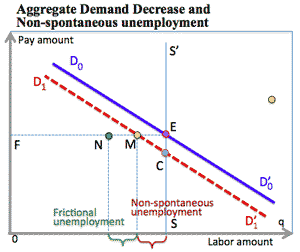
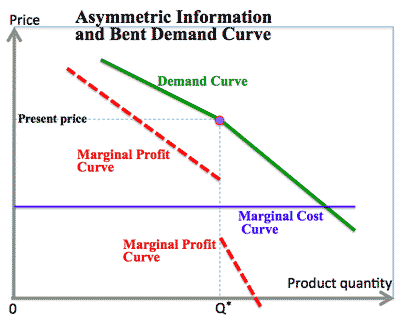
- 価格の硬直性
- 貸付利子率と期待収益率:
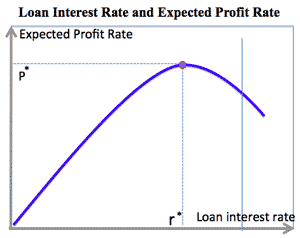
>Top 7. Japanese Economy in 1990s and Financial Uncertainty:
- James Tobin: "Liquidity trap" is happening in Japan since 1990:
- could not depend on financial policy.
- Fiscal policy will be difficult due to too much public debt.
- Unemployment rate is more than 5%, seeming no improvement.
- Balance sheet recession in banks and corporations matters.
- Japanese economic fundamentals have shown:
- GDP Growth: 9%+ until 1974 the first oil shock; then had shown 3-4% growth until 1990; but thereafter 0-1% growth.
- CPI (Consumer Price Index): around 6% until 1982; exceptionally more than 20% after the first oil shock (1975).
- CPI had been rather stable during the period of real estate bubble economy.
- Since 1990 CPI tends to show downward, i.e., deflation trend.
- The view about these facts are quite contrastive as follows:
- Japanese potentiality of economic growth should be higher; we should grow more.
- Japan has attained matured economy, could not expect high growth any more.; rather pursue GNH rather than GDP.
- Economic growth is determined by:
- Labor increase
- Technological development
- furthermore long-term growth depends on:
- Educational investment
- Deregulation and structural improvement
- Higher unemployment rate is serious problem; due to insufficiency of aggregate demand.
- Hitherto discussion on this issue has been confused short-term and long-term problems.
- Money Supply:
- In addition, money supply and object-economy are mutually related.
- According to mentalists, fluctuation of money supply only affects nominal GDP, doesn't affect real GDP.
- Money supply is the sum of cash and bank deposit.
- But credit amount by banks affects to corporate and household economic activities.
- Balance Sheet of Banks:
- Bank deposit is debt item, while Loan and Credit amount is asset items.
- Credit theory emphasizes that fluctuation of bank credit strongly relates object-economy.
- In particular corporate management may affect bank's stability.
- Conversely financial situation may affect corporate production and sales.
- Arbin Fisher: analyzed 1930 Great Depression:
- In economic depression period:
- Companies makes dumping to return debt.
- Causing price reduction, causing deflation.
- Causing to effective increase of corporate debt.
- Causing decrease of corporate asset value; deteriorating BS
- Causing decrease of production and employment
- Finally may cause bankruptcy
- Causing further negative impact to the economy
7. 1990年代の日本経済と金融不安
- トービン:"流動性の罠"
1990以降の日本
- 日本経済の基礎指標
- GDP
- CPI
- 貨幣量:
Comment
- Proper chart of economic trend is really eloquent.
- Asymmetry is a source of dynamism, causing some change favorably or unfavorably to us, which is similar to physical phenomenon.
- 適切な経済傾向の図は実に雄弁である。
- 非対称性は物理現象と同様に、ダイナミズムの源泉であり、我々にとって幸か不幸かある種の変化を生じさせるものである。
Asymmetric Information Economicsfrom Stigliz New Economics
|
Category: ECO |
|
Shiro Yabushita (藪下史郎) |
up 14830 |
Title |
Asymmetric Information Economics |
非対称情報の経済学 |
|---|---|---|
Index |
||
Tag |
Premises of perfect competitive market; Joseph E. Stigliz; Causes of asymmetric information; Adverse selection; Moral hazarad; Japanese labor practices; Institutionalism vs. Neoclassical economics; Stability vs. Efficiency Trade-off; Nash Equilibrium; Bent Demand Curve; Liquidity Trap; Money Supply; |
|
Summary |
要約 |
>Top 0. Preface:
|
0. 序文:
|
>Top 1. Limit of Traditional Economics:
|
1. 伝統的経済学の限界:
|
>Top 2. Birth of New Economics:
|
2. 新しい経済学の誕生:
|
>Top 3. Market under Asymmetric Information:
|
3. 非対称情報下の市場:
|
>Top 4. Moral Hazard and Economic Activities:
|
4. モラルハザードと経済活動:
|
>Top 5. Organization and Systems
|
5. 組織と制度:
|
>Top 6. Macro Economics and Asymmetric Information:
|
6. マクロ経済学と非対称情報:
|
>Top 7. Japanese Economy in 1990s and Financial Uncertainty:
|
7. 1990年代の日本経済と金融不安
|
Comment |
|
|